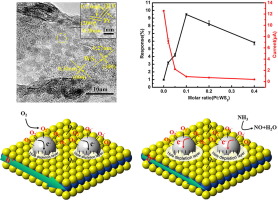当前位置:
X-MOL 学术
›
Appl. Surf. Sci.
›
论文详情
Our official English website, www.x-mol.net, welcomes your
feedback! (Note: you will need to create a separate account there.)
Two-dimensional WS 2 -based nanosheets modified by Pt quantum dots for enhanced room-temperature NH 3 sensing properties
Applied Surface Science ( IF 6.3 ) Pub Date : 2018-10-01 , DOI: 10.1016/j.apsusc.2018.05.148
Chao Ouyang , Yunxiang Chen , Ziyu Qin , Dawen Zeng , Jian Zhang , Hao Wang , Changsheng Xie
Applied Surface Science ( IF 6.3 ) Pub Date : 2018-10-01 , DOI: 10.1016/j.apsusc.2018.05.148
Chao Ouyang , Yunxiang Chen , Ziyu Qin , Dawen Zeng , Jian Zhang , Hao Wang , Changsheng Xie

|
Abstract As a typical two-dimensional (2D) layered transition metal dichalcogenides (TMDs), tungsten disulfide (WS2) has been considered as a promising sensing material for room-temperature NH3 detection. However, the bulk WS2-based room-temperature NH3 sensors can hardly recover to its initial state after turning off gas. Although the recovery rate of bulk WS2 was accelerated by thinning method, the response of few- or monolayer WS2 nanosheets (NSs) to NH3 was sharply decreased. Here, in premise of keeping fast recovery rate, few- or monolayer WS2 NSs modified with Pt quantum dots (QDs) were prepared for room-temperature NH3 detection, which exhibited significantly enhanced sensing properties with fast recovery speeds. Especially, the response of nanocomposite to 250 ppm NH3 is nearly 10 times than that of WS2 NSs, which could be attributed to the significantly decreased initial conductivity caused by electrons flowing from higher Fermi level of Pt QDs to that of WS2 NSs and the higher catalytic activity. Furthermore, the Pt S bonds confirmed by XPS results could benefit electrons transfer between the interface. We hope that the 0D/2D heterostructure system in this work could provide a direction to improve sensing properties of 2D TMDs-based room-temperature sensors.
中文翻译:

由 Pt 量子点修饰的二维 WS 2 基纳米片以增强室温 NH 3 传感特性
摘要 作为典型的二维 (2D) 层状过渡金属二硫属化物 (TMD),二硫化钨 (WS2) 被认为是一种很有前途的室温 NH3 检测传感材料。然而,基于 WS2 的散装室温 NH3 传感器在关闭气体后很难恢复到其初始状态。尽管通过减薄方法加快了块体 WS2 的回收率,但少量或单层 WS2 纳米片 (NSs) 对 NH3 的响应急剧下降。在这里,在保持快速恢复率的前提下,制备了少量或单层的 Pt 量子点(QD)修饰的 WS2 NSs 用于室温 NH3 检测,其表现出显着增强的传感性能和快速恢复速度。特别是纳米复合材料对 250 ppm NH3 的响应是 WS2 NSs 的近 10 倍,这可能是由于电子从 Pt QD 的较高费米能级流向 WS2 NSs 的电子流导致初始电导率显着降低,以及更高的催化活性。此外,XPS 结果证实的 Pt S 键可能有利于界面之间的电子转移。我们希望这项工作中的 0D/2D 异质结构系统可以为改善基于 2D TMD 的室温传感器的传感特性提供一个方向。
更新日期:2018-10-01
中文翻译:

由 Pt 量子点修饰的二维 WS 2 基纳米片以增强室温 NH 3 传感特性
摘要 作为典型的二维 (2D) 层状过渡金属二硫属化物 (TMD),二硫化钨 (WS2) 被认为是一种很有前途的室温 NH3 检测传感材料。然而,基于 WS2 的散装室温 NH3 传感器在关闭气体后很难恢复到其初始状态。尽管通过减薄方法加快了块体 WS2 的回收率,但少量或单层 WS2 纳米片 (NSs) 对 NH3 的响应急剧下降。在这里,在保持快速恢复率的前提下,制备了少量或单层的 Pt 量子点(QD)修饰的 WS2 NSs 用于室温 NH3 检测,其表现出显着增强的传感性能和快速恢复速度。特别是纳米复合材料对 250 ppm NH3 的响应是 WS2 NSs 的近 10 倍,这可能是由于电子从 Pt QD 的较高费米能级流向 WS2 NSs 的电子流导致初始电导率显着降低,以及更高的催化活性。此外,XPS 结果证实的 Pt S 键可能有利于界面之间的电子转移。我们希望这项工作中的 0D/2D 异质结构系统可以为改善基于 2D TMD 的室温传感器的传感特性提供一个方向。







































 京公网安备 11010802027423号
京公网安备 11010802027423号